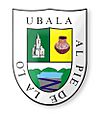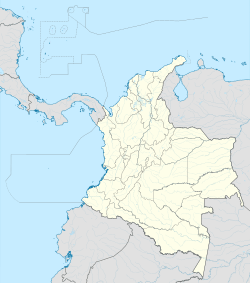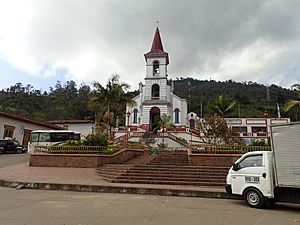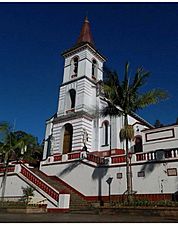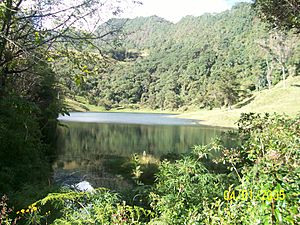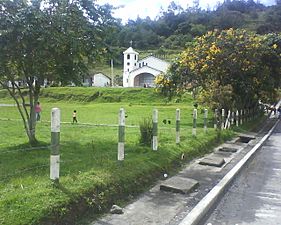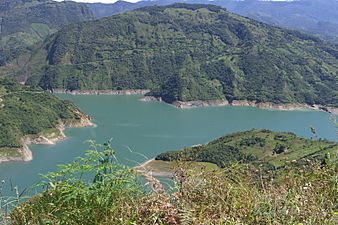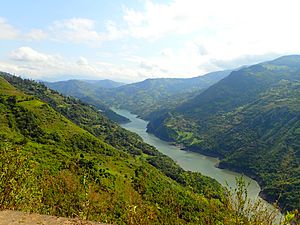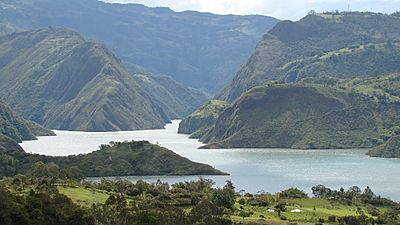Ubalá facts for kids
Quick facts for kids
Ubalá
|
|||
|---|---|---|---|
|
Municipality and town
|
|||
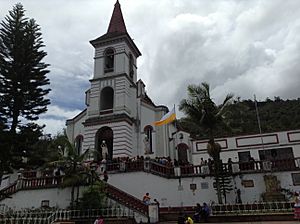
Church of Ubalá
|
|||
|
|||
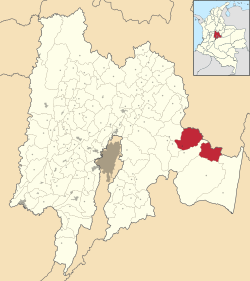
Location of the municipality and town inside Cundinamarca Department of Colombia
|
|||
| Country | |||
| Department | |||
| Province | Guavio Province | ||
| Founded | 23 October 1846 | ||
| Founded by | Ospina Rodríguez | ||
| Area | |||
| • Municipality and town | 505 km2 (195 sq mi) | ||
| Elevation | 1,949 m (6,394 ft) | ||
| Population
(2015)
|
|||
| • Municipality and town | 10,718 | ||
| • Density | 21.224/km2 (54.97/sq mi) | ||
| • Urban | 1,280 | ||
| Time zone | UTC-5 (Colombia Standard Time) | ||
| Website | Official website: http://www.ubala-cundinamarca.gov.co/ | ||
Ubalá is a town and a municipality (which is like a local government area) in Colombia. It is part of the Cundinamarca department. Ubalá is found in the Eastern Mountains of the Colombian Andes. It is special because it is the only municipality in Cundinamarca that is split into two separate parts.
Contents
What's the Weather Like in Ubalá?
Ubalá has a mild climate because it is located in the mountains. The temperature stays fairly consistent throughout the year. It also receives a lot of rain, especially from April to August.
| Weather chart for
|
|||||||||||||||||||||||||||||||||||||||||||||||
|---|---|---|---|---|---|---|---|---|---|---|---|---|---|---|---|---|---|---|---|---|---|---|---|---|---|---|---|---|---|---|---|---|---|---|---|---|---|---|---|---|---|---|---|---|---|---|---|
| J | F | M | A | M | J | J | A | S | O | N | D | ||||||||||||||||||||||||||||||||||||
|
47
23
11
|
93
24
12
|
136
24
13
|
216
23
14
|
290
22
14
|
360
21
13
|
332
21
13
|
276
21
13
|
205
22
12
|
188
22
13
|
132
23
13
|
72
23
12
|
||||||||||||||||||||||||||||||||||||
| temperatures in °C precipitation totals in mm source: Climate-data.org - Ubalá |
|||||||||||||||||||||||||||||||||||||||||||||||
|
Imperial conversion
|
|||||||||||||||||||||||||||||||||||||||||||||||
Where Does the Name Ubalá Come From?
The name Ubalá comes from the Chibcha language. This was the language spoken by the Muisca, who lived in this area long ago. In their language, Ubalá means "Place on the hillside" or "At the foot of the hillside."
A Look Back: Ubalá's History
Before the Spanish arrived, the area west of Ubalá was home to the Muisca. To the east lived the Tegua, and to the south were the Guayupe. These were all different groups of indigenous people.
Ubalá was officially founded on October 23, 1846. It was established by a person named Ospina Rodríguez.
How Ubalá is Organized
Ubalá is unique because it is divided into two main geographical parts. Each part has its own smaller areas called "municipal inspections," and these inspections are made up of several villages.
Ubalá A (Western Part)
This part of Ubalá is very mountainous. It is located along the northern shore of the Guavio Reservoir, which is a large artificial lake. Some of the main inspections in this part include:
- Central: This area includes the main town of Ubalá (called Sagrado Corazón) and several villages like El Carmelo and San Antonio de Ubalá.
- Santa Rosa: This inspection was created a long time ago, in 1907. It includes villages such as Cascajal and Santa Rosa.
- Laguna Azul: This area has villages like Betania, El Eden, and Laguna Azul.
- La Playa: Villages here include La Playa and Mundo Nuevo.
- Peñas Blancas: This inspection contains villages like Cascades and Peñas Blancas.
Ubalá B (Eastern Part)
The eastern part of Ubalá is known for the Medina cliffs. These cliffs separate the Guavio region from the flat plains of the Orinoquía. This part includes three main inspections:
- Mambita: Villages in this inspection include Algodones, La Floresta, and Mambita.
- Soy: This area has villages like Gibraltar and Soya.
- San Pedro de Jagua: Villages here include Puerto Rico and San Pedro de Jagua.
What Ubalá Produces: Economy
The main way people in Ubalá make a living is through mining. They dig for valuable minerals and materials from the ground. The most important things they find are emeralds, which are beautiful green gemstones. They also mine for iron ore, sandstones, clay, and salt.
Photo Gallery
See also
 In Spanish: Ubalá para niños
In Spanish: Ubalá para niños



